Multiple Choice
Identify the
choice that best completes the statement or answers the question.
|
|
|
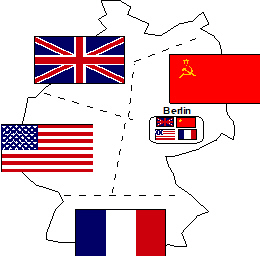
Divided Germany.
Notice the city of Berlin divided into Eastern (Soviet) areas and Western
areas. | If you remember from a previous lesson, Germany was divided into sectors after
World War II. The city of Berlin was in the Soviet sector (East Germany) and it too was divided into
sectors. Look at the map on the left.
The British, American and French areas of Germany became
known as “West”
Germany. The Soviet area of Germany became known as “East” Germany
The
Soviets did not like having the Western powers inside the city of Berlin which was in East
Germany. By 1960 the West areas of Germany and the West areas of Berlin were rich and
prosperous. Business was thriving, the cities were remodeled and life was good for the citizens of
West Germany. In East Germany the Soviet areas of Germany were still in ruins, as they were at the
end of World War II.
| | |
|
|
|
1.
|
The American, French and
British areas of Berlin were known as _____ Berlin, while the Soviet area of Berlin was known as
_____ Berlin.
a. | Eastern -
Western | c. | Communist -
Soviet | b. | Western - Eastern | d. | Communist - Capitalist |
|
|
|
2.
|
Life in East Berlin was an
example of the _____ of the communist system
a. | failure | c. | technology | b. | success | d. | power |
|
|
|
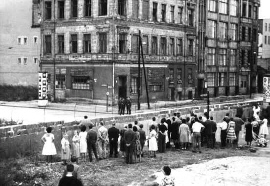 | For years, West Berlin was an escape route for East Germans seeking to flee
communism. But growing Cold War tensions forced the Soviet bloc to erect a deadly blockade across the
city -- a Wall that divided Berlin for nearly three decades.
| | |
|
|
|
3.
|
How long did the Berlin Wall
stay in place?
a. | 300
years | c. | 30
years | b. | 30 months | d. | 3 years |
|
|
|
4.
|
Who used the wall as an escape
route?
a. | Soviets trying to escape to East
Germany | c. | East Germans
trying to escape to the Soviet Sector | b. | West Germans trying to escape to the Eastern
Sector | d. | East Germans fleeing to the
West |
|
|
|
BERLIN
After World War II the Soviets kept their vast armies and even increased their numbers.
They were a powerful military machine. In order to defend against Soviet aggression, the Western
countries joined together and formed a joint military force called, “NATO.” By 1958, West
Germany was NATO's front line along the Iron Curtain.
Berlin, meanwhile, was creating a
different kind of nightmare for the Soviet bloc. The city was still under the joint occupation of
France, Britain, the U.S.S.R. and the United States -- an arrangement that began when the four powers
were wartime allies. Berliners could move freely between the city's Eastern and Western sectors,
allowing the East Germans to see how well the West Germans were living..
West Berlin was
considered a danger to the existence of East Germany. Nikita Khrushchev proposed Berlin become a
"free city," with its own foreign policy. But the West rejected Khrushchev's idea
because they realized that Khrushchev really wanted to control the entire city of
Berlin..
|
|
|
5.
|
The Western allies joined
together to form a military organization to defend against Soviet aggression. This army was called
_____
a. | WEST
SETO | c. | NATO | b. | THE MACHINE | d. | EAST NATO |
|
|
|
6.
|
Why did the Soviet bloc
not want the Berliners
moving back and forth between the East and West sectors?
a. | they did not want the West Berliners
to see how good the East Berliners were living. | c. | they did not want the East Berliners to see how good the West Berliners were
living. | b. | they did not want the East Berliners to become
communist | d. | they did not care if Berliners moved
back and forth |
|
|
|
KHRUSHCHEV
Khrushchev issued a new demand, calling on the Western
powers to withdraw from Berlin or the Soviet bloc might take military action to throw the West out.
Ensuing talks between the West and the U.S.S.R. got nowhere. But the talks persuaded Khrushchev to
put aside his Berlin ultimatum. In September 1959, he became the first Soviet leader to visit
the United States, where he met with President Eisenhower.
A second Eisenhower-Khrushchev summit
collapsed before it had even begun -- following the shoot-down of an American U-2 spy plane, which
had been flying over Soviet airspace
| | | |
|
|
|
7.
|
What did Khrushchev want the
West to do about Berlin?
a. | get out | c. | share power | b. | stay | d. | bring NATO in |
|
|
|
8.
|
Who was President of the United
States in 1959
a. | Franklin
Roosevelt | c. | Truman | b. | John F. Kennedy | d. | Eisenhower |
|
|
|
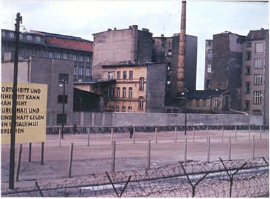 | EAST GERMANY
By the end of the 1950s, East Germany portrayed itself as a socialist paradise. But the
reality was far different. Dependence on heavy industry created shortages of essential goods and
consumer items. East Germany knew it could not compete with the swelling prosperity of West Germany.
Every month, thousands of East Germans fled across the open Berlin border and took refuge in the
West. Most of the refugees were young and skilled. Their departure was bleeding the East German
economy to death. East German leader Walter Ulbricht urged Khrushchev to recognize East Germany as a
sovereign state.
| | |
|
|
|
9.
|
By the end of the 1950’s
_____ Germany was prosperous, in contrast to _____ Germany
a. | East -
Soviet | c. | Soviet -
East | b. | West - East | d. | West - American Sector |
|
|
|
10.
|
How did the escape of East
Germans into West Germany through Berlin hurt the East German economy?
a. | Many of the people escaping were
German spies. | c. | Most of the people
escaping were young people with skills that East Germany needed for its
economy. | b. | Most of the people escaping were young people with educations that West
Germany needed for its economy | d. | Most of the people escaping were unskilled labor that the East needed for
manual labor. |
|
|
|
11.
|
East German leader Walter
Ulbricht urged Khrushchev to recognize East Germany as a sovereign state. What does this tell you
about the relationship of East Germany to the Soviet Union?
a. | the Soviets were dictators over East
Germany | c. | the Soviets were
inferior to the East Germans | b. | the East Germans were afraid of the West | d. | West Germany was inferior to East
Germany |
|
|
|
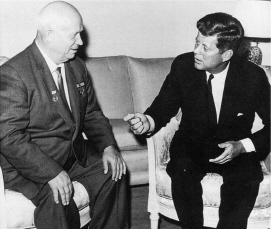
Khrushchev and Kennedy at the Vienna Summit in 1961
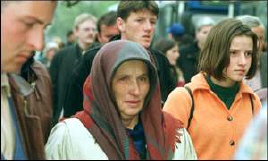
German Refugees Trying to Escape Communism | THE
WALL
John F. Kennedy became
U.S. president in January 1961. He agreed to meet Khrushchev and other world leaders in June of
that year. The other world leaders at the Summit were “Giants” of world history and had
led their countries through World War II. Kennedy was young and inexperienced and the other
leaders did not respect him. Shortly before the summit in Vienna, Kennedy attempted to invade
Castro's Cuba, at the Bay of Pigs, and failed miserably. Khrushchev attempted to bully Kennedy
at the summit, warning him that Soviet bloc forces could invade West Berlin at any time.
By that
time, the flow of refugees from East to West Berlin had become a torrent. East German officials
begged Moscow to let them stem the flow. On the morning of August 13, 1961, East German and Soviet
troops sealed the East Berlin side of the border, closing crossing points and erecting barricades.
The Berlin wall was erected and Berlin was divided.
| | |
|
|
|
12.
|
Why did Khrushchev believe that
he could bully and threaten President Kennedy?
a. | Kennedy was also a
dictator | c. | Kennedy was
perceived to be tough because he tried to invade Cuba | b. | Khrushchev was mentally
unbalanced | d. | Kennedy was inexperienced in world
affairs |
|
|
|
13.
|
Most experts agree that
Khrushchev would never have agreed to build a wall between East and West Berlin if Eisenhower were
still in office. Why did Khrushchev think he could erect a wall with Kennedy in
office?
a. | Kennedy was busy in Korea and
Cuba | c. | The experts were
wrong | b. | Khrushchev thought Kennedy would not respond to Soviet
aggression | d. | Kennedy also wanted a
wall |
|
|
|
14.
|
Khrushchev was to Kennedy as a
teacher is to _____
a. | a misbehaving
student | c. | the principal of a
school | b. | the parent of a student | d. | the police |
|
|
|
15.
|
The flow of refugees from East
to West Berlin showed that ...
a. | there were too many people in East
Berlin | c. | Communism was a
failure | b. | there were too many people in West Berlin | d. | Communism was a success |
|
|
|
DIVIDED
Angry West Berliners demonstrated against the division of
their city, a divide that separated many families. The allies were unsure how to react -- their
rights within Berlin had not been challenged by the Soviets. But a border crossing confrontation
prompted U.S. Gen. Lucius Clay to bring up tanks. The Soviets responded with their own show of force.
Both sides later withdrew their armor.
Many in the East, meanwhile, risked death to flee across
the Wall. Within the first year, 50 Germans died trying to cross to the West. One of them,
18-year-old Peter Fechter, bled to death in the no-man's land between East and West, in front of
outraged West Berliners.
In 1963, Kennedy visited West Berlin -- telling its residents that all
free people were citizens of Berlin and "therefore as a free man, I take pride in the words,
'Ich bin ein Berliner.'"
Yet for the next three decades, the Wall remained a
symbol of the Cold War's cruelty and Europe's division. Its message was a bitter one:
Whatever happened beyond that line, the West might lament, but would not
interfere.
| 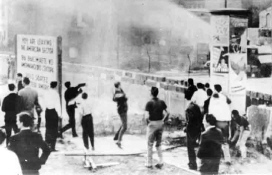
Demonstrations
against the Berlin Wall
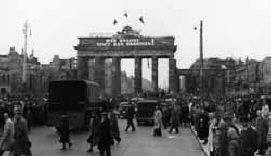 | | |
|
|
|
16.
|
How did Germans react to the
building of a wall that divided the city
a. | with fear of the East Berlin
government | c. | with anger and
protestations | b. | with fear of the West Berlin government | d. | with anger at the weak American
President |
|
|
|
17.
|
How did the Allied Powers react
to the erection of the Berlin wall?
a. | They were not sure what to
do | c. | Calling a special session of
Congress | b. | They were sure and resolute | d. | They threatened to declare war on the Soviet
Union |
|
|
|
18.
|
By finally accepting the Berlin
wall, the West was really saying that ...
a. | it was most likely a good thing to
have a wall between East and West Berlin | c. | it would not interfere in the affairs of West
Germany | b. | the Berlin Airlift was a failure | d. | it would not interfere with the affairs of East Germany and the Soviet
occupation |
|
|
|
19.
|
When President Kennedy told the
people of Berlin, 'Ich bin ein Berliner,” he was showing ___ for the Soviet Union and
_____ with the people of Berlin
a. | joy -
anger | c. | contempt -
unity | b. | fear - unity | d. | dislike - frustration |
|
|
|
20.
|
How did the people of Berlin
react to President Kennedy’s speech?
a. | hatred and contempt for the
President | c. | anger at President
Kennedy | b. | joy and affection for President Kennedy | d. | fear of the Soviet Union |
|